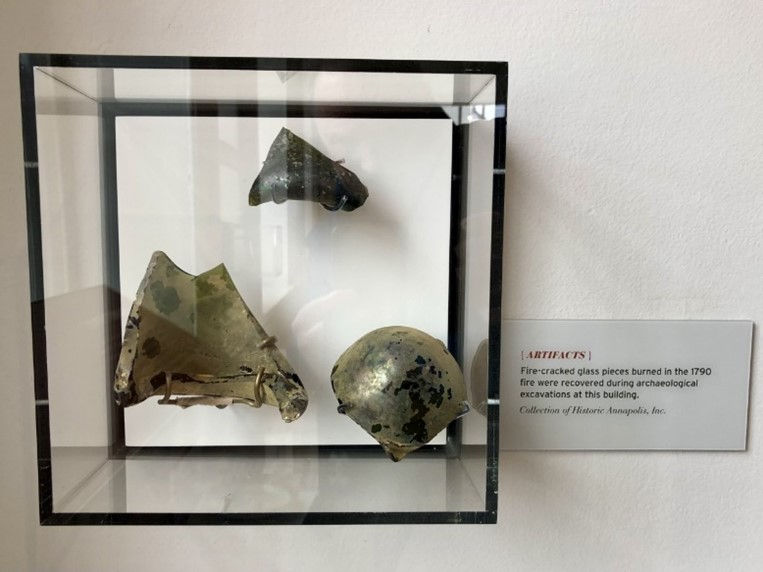Making A Mark
- HistoricAnnapolis

- May 25, 2020
- 4 min read
The Historic Annapolis Historic Marker program – 300 strong and still growing.

I was first introduced to the historic marker program in 2002. My husband and had I bought our first home on upper Cornhill Street, and my parents purchased a marker for us as a housewarming present. Our home was listed as a “dollhouse,” measuring less than 1,000 square feet over three floors, and I fell in love with it immediately. I feared that my 6’1” tall husband would object to the idea of purchasing a small-scaled, 180-year-old dwelling, but he quickly embraced old home living, and we have fond memories of the eight years we lived there. The light-blue painted marker (representing the Federal style) was a perfect complement to our bright-blue door.
In our old home, we had growth, we had loss. We have wonderful memories of block parties with our close neighbors and Sunday suppers with the midshipmen we sponsored, crowded around our small dining room table. We loved hearing stories about those who lived there before us. One that comes to mind is Elizabeth Pearson, an elderly widow who would recite Shakespearean sonnets to a neighbor who shoveled her stoop in the winter. I imagine the words landing softy on the snow, gently being brushed away.

58 Cornhill is one in a series of four single-family brick homes, built in 1821 by speculative developer Jeremiah Hughes. Following the sale of 60 Cornhill in 1822, the remaining three houses (54 to 58 Cornhill) were owned as a collective and used as working-class rental properties until the mid-20th century. The architectural style is classified as “Vernacular Federal” and is defined by a few architectural details – a corbelled cornice, a side-entry door with a transom, and a standing-seam metal roof. And while the buildings have been modified over the years, they continue to set a tone for the street in terms of rhythm, massing, and materials. It remains one of my favorite places in the Annapolis Historic District.
Cornhill Street boasts many historic markers.
"We in Historic Annapolis are proud of the immense significance of Maryland’s capital city.” - St. Clair Wright
This program was started over fifty years ago by St. Clair Wright, former HA matriarch, who raffled off a Caribbean cruise to raise money for the first batch of markers. She selected six colors to represent six architectural styles found throughout the district, from “Colonial Red” to “Chesapeake Gray.” The octagonal shape of the marker derives from an interior window surround found in the Hammond-Harwood and William Paca houses. The Liberty Tree stands proudly in the middle, with raised lettering on the surrounding border of the marker to associate the buildings with the Annapolis Historic Landmark District.
In a memorandum from Mrs. Wright, dated May 15, 1967, to Mr. Harvey Ewing, thanking him for participating in the marker introduction ceremony, she wrote: “While their [historic buildings’] decorative and architectural merits are important, the sense of history they impart and the association with the past are more so. Young people particularly benefit from the security of such associations and the feeling of involvement with the continuing cultural development of this country. Now in our own era the importance to the individual of the environment in which he lives is at last understood. We in Historic Annapolis are proud of the immense significance of Maryland’s capital city.”

Today the marker program is 300 strong and continuing to grow. More than a third of the markers on display are painted “Chesapeake Gray,” representing Annapolis Vernacular buildings that date to the early 20th century. Prince George Street is the frontrunner in the number of buildings that have a marker (38 in total), with Duke of Gloucester in a close second (29 markers) and Conduit in third place with 25 on display. Another interesting statistic is that Franklin Street has the most yellow markers, representing the “20th Century Distinctive” category. This category recognizes important architectural designs from the early 1900s, such as four-squares and bungalows, many of which are found throughout this area of the historic district which overlaps with the Murray Hill neighborhood.
The marker program is one of my favorite projects that we in the Preservation Division manage. Through this program, we’ve had the great opportunity to become acquainted with many owners of historic homes in the district and welcome these families into our preservation community. A few years back, Joe Kuchuk, HA’s Facility Manager, and I installed a marker for Diane Rey at her home on Fleet Street. In the rain, no less, Joe hung the marker while Diane recited a tribute to those who lived in the house before her.
Earlier this spring we installed a marker for Dana and John Mascali at their lovely home on Prince George Street.
Dana could not contain her enthusiasm for her “blue ribbon” now on display. She shared with us her passion and plans for her new home, over a glass of Prosecco, while we chatted about the features that make her building special. This building is classified as a hybrid, exhibiting early Federal period construction and later 20th century alterations (note the Colonial Revival door surround, and the bracketed cornice that ties two building campaigns together).
Another marker property that comes to mind is Susie and Craig Hamner’s mid-19th century home on Hanover Street.

This building has an interesting history as a saloon, a grocery, and later a drug store. After its commericial use days ended, the building functioned as a duplex and eventually was converted to a single-family home. Now this USNA alumni and his family have made it their permanent residence. These families well represent the “honored recipients...inspired to restore and protect their historic structures...” that Mrs. Wright spoke of with such optimism in 1967.
This summer our staff may be seen around the district touching up paint on faded markers. If your marker needs a little “sprucing up,” please let us know. Also, if you are interested in exploring whether your property is eligible for the marker program, please contact Carolyn Currin at carolyn.currin@annapolis.org. Along with the purchase of a marker comes a one-year HA membership, and includes membership in the Preservation Circle. We look forward to hosting more Circle member gatherings and reengaging with the preservation community in person, as soon as we can all reconvene.
Karen Theimer Brown Vice President, Preservation
#preservation #annapolis #historicpreservation #historicannapolis #preserve #protect #connect #annapolis #architecture #historicdistrict
Are you enjoying our posts? We invite you to consider making a tax-deductible contribution to Historic Annapolis to help sustain our organization through this difficult time. Thank you!




























Comments